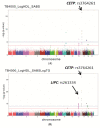Functional Haplotype of LIPC Induces Triglyceride-Mediated Suppression of HDL-C Levels According to Genome-Wide Association Studies
- PMID: 33499410
- PMCID: PMC7910859
- DOI: 10.3390/genes12020148
Functional Haplotype of LIPC Induces Triglyceride-Mediated Suppression of HDL-C Levels According to Genome-Wide Association Studies
Abstract
Hepatic lipase (encoded by LIPC) is a glycoprotein in the triacylglycerol lipase family and mainly synthesized in and secreted from the liver. Previous studies demonstrated that hepatic lipase is crucial for reverse cholesterol transport and modulating metabolism and the plasma levels of several lipoproteins. This study was conducted to investigate the suppression effect of high-density lipoprotein cholesterol (HDL-C) levels in a genome-wide association study and explore the possible mechanisms linking triglyceride (TG) to LIPC variants and HDL-C. Genome-wide association data for TG and HDL-C were available for 4657 Taiwan-biobank participants. The prevalence of haplotypes in the LIPC promoter region and their effects were calculated. The cloned constructs of the haplotypes were expressed transiently in HepG2 cells and evaluated in a luciferase reporter assay. Genome-wide association analysis revealed that HDL-C was significantly associated with variations in LIPC after adjusting for TG. Three haplotypes (H1: TCG, H2: CTA and H3: CCA) in LIPC were identified. H2: CTA was significantly associated with HDL-C levels and H1: TCG suppressed HDL-C levels when a third factor, TG, was included in mediation analysis. The luciferase reporter assay further showed that the H2: CTA haplotype significantly inhibited luciferase activity compared with the H1: TCG haplotype. In conclusion, we identified a suppressive role for TG in the genome-wide association between LIPC and HDL-C. A functional haplotype of hepatic lipase may reduce HDL-C levels and is suppressed by TG.
Keywords: genome-wide association study; hepatic lipase; high-density lipoprotein cholesterol; suppression effect; triglyceride.
Conflict of interest statement
The authors declare no conflict of interest and the funders had no role in the design of the study; in the collection, analyses or interpretation of data; in the writing of the manuscript or in the decision to publish the results.
Figures



References
Publication types
MeSH terms
Substances
LinkOut - more resources
Full Text Sources
Other Literature Sources
Medical
Molecular Biology Databases
Miscellaneous

